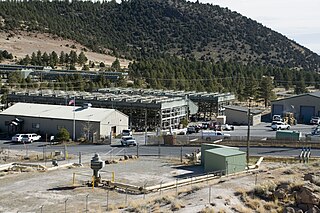
Geothermal energy is thermal energy extracted from the Earth's crust. It combines energy from the formation of the planet and from radioactive decay. Geothermal energy has been exploited as a source of heat and/or electric power for millennia.

Kawerau is a town in the Bay of Plenty Region on the North Island of New Zealand. It is situated 100 km south-east of Tauranga and 58 km east of Rotorua. It is the seat of the Kawerau District Council, and the only town in Kawerau District.

Mercury NZ Limited is a New Zealand electricity generation and multi-product utility retailer of electricity, gas, broadband and mobile telephone services. All the company's electricity generation is renewable. Mercury has a pre-paid electricity product sub-brand GLOBUG. Mercury Energy is also the largest electricity retailer in New Zealand.
A binary cycle is a method for generating electrical power from geothermal resources and employs two separate fluid cycles, hence binary cycle. The primary cycle extracts the geothermal energy from the reservoir, and secondary cycle converts the heat into work to drive the generator and generate electricity.

Geothermal power is electrical power generated from geothermal energy. Technologies in use include dry steam power stations, flash steam power stations and binary cycle power stations. Geothermal electricity generation is currently used in 26 countries, while geothermal heating is in use in 70 countries.
The electricity sector in New Zealand uses mainly renewable energy, such as hydropower, geothermal power and increasingly wind energy. As of 2019, 82% of electricity is generated from renewable sources, making New Zealand one of the countries with the lowest carbon dioxide emissions from electricity generation. Electricity demand grew by an average of 2.1% per year from 1974 to 2010 but decreased by 1.2% from 2010 to 2013.
The Te Huka Geothermal Power Station, also known as Tauhara One, is a 23 MW binary cycle geothermal power station situated near Taupō, New Zealand. The power station is operated by Contact Energy.

The Wairakei Power Station is a geothermal power station near the Wairakei Geothermal Field in New Zealand. Wairakei lies in the Taupō Volcanic Zone.

The Ohaaki Power Station is a geothermal power station owned and operated by Contact Energy. A distinctive feature of this power station is the 105 m high natural draft cooling tower, the only one of its kind in New Zealand.
The Poihipi Power Station is a geothermal power station owned and operated by Contact Energy. It is located on Poihipi Road near Taupō in New Zealand.
The Tasman Mill site is a pulp and paper mill located on Fletcher Avenue just outside the town of Kawerau in New Zealand. The Tasman Mill site is the largest single employer in the Eastern Bay of Plenty region. Three pulp or paper companies previously operated in Kawerau: Norske Skog operated the mechanical pulp mill and newsprint paper mill; Oji Fibre Solutions, formerly Carter Holt Harvey, operated the kraft pulp mill; and SCA who manufacture tissue and base paper.

Southdown Power Station was a natural gas-fired combined cycle gas turbine cogeneration power station in Southdown, a suburb in southern Auckland, New Zealand. When operational, it was New Zealand's northernmost power station with a capacity exceeding 50 MW.

Svartsengi power station is a geothermal power plant, which is located in the Svartsengi geothermal field, about 4 kilometres (2.5 mi) north of Grindavík, approximately 20 km (12 mi) SE of Keflavík International Airport and 45 km (28 mi) from Reykjavík. The electric power station was built in 1976 by HS Orka. It was the world's first combined geothermal power plant for electric power generation and hot water production for district heating.
Ngatamariki is a geothermal power station commissioned in 2013 and operated by Mercury Energy. It is located approximately 17 km north east of Taupō and was constructed well under the budget of $475 million.

Ormat Technologies, Inc. is an international company based in Reno, Nevada, United States. Ormat supplies alternative and renewable geothermal energy technology. The company has built over 190 power plants and installed over 3,200 MW. As of January 2021 it owns and operates 933 MW of geothermal and recovered energy based power plants. Ormat has supplied over 1000 turbochargers worldwide: North America, South America, Europe, Australia, and Asia. The company's products also include turbines, generators, and heat exchangers.
The Mokai Power Station is a geothermal power station owned by the Tuaropaki Power Company and operated by Mercury NZ Limited. It is located approximately 30 km north west of Taupō in New Zealand. The station uses a binary cycle manufactured by Ormat Industries.
Top Energy Limited is an electricity distribution and generation company based in Kerikeri, New Zealand. It owns and manages the electricity lines network in the Far North District of New Zealand, including Kaitaia, Kerikeri and Kaikohe. The service area covers 6,822 km2 and serves over 32,000 customers. It also owns and operates the Ngāwhā Geothermal Power Station.

The Puna Geothermal Venture (PGV) is a geothermal energy power plant on the island of Hawaii, the largest island in the state of Hawaii. The plant was shut down shortly after the start of the May 2018 lower Puna eruption, and resumed power generation in November 2020. The eruption had caused lava to flow over a PGV power substation, a warehouse and at least three geothermal wells that had been preventatively quenched and capped when lava fountains erupted nearby, eventually also cutting off road access.

The Mammoth Geothermal Complex is a complex of 4 geothermal power stations located at Casa Diablo Hot Springs about 3 miles (4.8 km) east of Mammoth Lakes, California. The complex is owned by Ormat and operated by its subsidiary Mammoth Pacific.



















